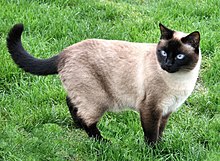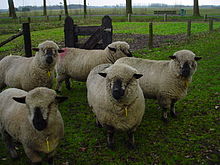Point coloration

Point coloration refers to animal coat coloration with a pale body and relatively darker extremities, i.e. the face, ears, feet, tail, and (in males) scrotum. It is most recognized as the coloration of Siamese and related breeds of cat, but can be found in dogs, rabbits, rats, sheep, guinea pigs and horses as well.
In cats[]


Point coloration in cats originated in the Siamese and closely related Asian breeds, and is found in many Western-developed modern breeds. It is a form of partial albinism resulting from a mutation that affects tyrosinase, an enzyme involved with melanin production. The mutated enzyme is thermolabile; it fails to work at normal body temperatures, but becomes active in cooler areas of the skin.[1] As a result, dark pigment is limited to the coldest areas of the body, that is, the extremities. Pointed kittens are born white, since the womb is uniformly warm. As the kitten ages, the cooler areas darken while warmer areas remain cream to white in color. Points are not limited to solid colors or dark colors. It is possible to have a red (orange color) or fawn (pale warm gray) point. It is also possible to have a tortoiseshell or tabby point. A cat (of any breed) with this coloration is often called a colorpoint cat to distinguish it from others.
As the expression of the gene responsible for the pointed pattern is regulated by temperature, pointed cats who live in cooler environments often show increased darkening of their fur relative to cats who live in warmer climates, sometimes even developing large dark areas along their sides.
Because of the pigment restriction caused by the temperature sensitive tyrosinase, pointed cat's eyes are always shades of blue because the blue layer in the eye common to all cats is not covered by another color. The back of the eye also lacks pigment, giving colorpoint cats' pupils an eerie red and silver reflection in the dark, unlike a normally pigmented cat's shining silver-green or -blue.
The point gene allele is at the C locus, where pure albinism is also carried, and is written as cs. Point is recessive, so two copies of cs, one from each parent, are needed for points to be expressed. Also carried on the C locus is the gene for the . This is the darkest of all of the pigment restricting patterns—pigment is only paled at the warmest point in the body: the abdomen. The sepia allele is represented by cb. When a cat carries the genes cs and cb, the is formed, in which the pigment distribution is between sepia and point.
The lynx point pattern is formed by mating a colorpoint cat with a tabby cat (or breeding cats that already possess the lynx point pattern). It is characterized by a mixture of the darkening (reduced) of point coloration with distinct tabby striping on the head, tail, and legs, and an otherwise uniform and comparatively pale body. It is an accepted pattern in some cat registries, but not others, for particular breeds (mostly Siamese-related).[2]
Point coloration is inherent to the Siamese breed and some other closely related breeds but with most other breeds the colorpoints (including lynx) were brought into some breed lines long after their establishment, but there are exceptions. For example, lynx point was a feature of some of the foundation stock of the Siberian.[3]
Cat breeds[]
- Balinese
- Birman
- British Shorthair
- Colorpoint Shorthair
- Highlander
- Himalayan
- Javanese
- Napoleon
- Peterbald
- Ragamuffin
- Ragdoll
- Sphynx
- Siamese
- Neva Masquerade
- Snowshoe
- Thai
- Tonkinese
In dogs[]
This section needs expansion. You can help by . (March 2021) |
Pointed dogs include pugs, chocolate, Rottweilers, tan, and rare dog colors.
In horses[]


In horses, point coloration is produced by the action of the agouti gene. It acts on the extension gene, when present, to suppress black color to all but the extremities of the horse; the legs, mane, tail and tips of the ears. If the extension gene is not present, the effect of agouti is not visible, as there is no black color present to suppress. Points are most typically seen on a bay-colored horse, which has a black mane, tail, legs, and ear tips while the body and head will show the underlying chestnut or "red" base color. Point coloration may also be visible on horses with dilution genes that act upon a bay base coat, such as the dun gene and a single copy of the cream gene. Other genes or white markings may affect a horse's coat color in addition to agouti, and if present, can further alter or suppress black hair color and may mask any point coloration. Any horse breed may have point coloration with the exception of a very small number of horse breeds where humans have specifically used selective breeding to eliminate the agouti gene.
Horse coat colors with visible points[]
- Bay
- Bay or "Zebra" Dun
- Buckskin
- Bay pinto
- Amber Champagne
In rabbits and rodents[]

All pointed white rabbits of true breeding have red eyes.[4] The pointed white rabbit is created with the ch gene.[5] Its presentation is typified in the Himalayan rabbit breed (the first rabbit breed with a pointed white coat) and in the Californian breed.
Rabbit coat colors[]
Some rabbits that appear to be pointed white lack the red eyes, which indicates they are of different breeding. The following such coat colors are examples of those created, not with the ch gene, but with the cchl, cchd, or cchm gene in conjunction with the e gene:[citation needed]
- Blue point
- Chocolate point
- Lilac point
- Pearl
- Sable point
- Sallander
- Seal point
- Siamese
No pointed white rabbit can produce orange pigment; therefore, the points are always either black, blue, chocolate, or lilac.[citation needed] The resulting point coloration is sometimes in conjunction with a coat pattern, such as: white agouti, marten, broken, Vienna, or harlequin. (Such coats may not be recognized for showing.)
Rabbit breeds[]
Breeds of rabbit that include varieties with point coloration include:[6][7]
- Altex
- American Fuzzy Lop
- English Angora
- French Angora
- Californian
- Cashmere Lop
- Himalayan
- Holland Lop
- Jersey Wooly
- Lionhead
- Mini Lop
- Mini Rex
- (in development)
- Netherland Dwarf
- Rex
- Satin Angora
In fancy (domestic) rats[]
The C - Albino locus gene causes dilution of yellow and black coloration, causing Himalayan or Siamese markings depending on the allele is affected.
Point colors in rats include:
- Sepia
- Seal Point
- Blue Point[8]
In guinea pigs[]
This section needs expansion. You can help by . (May 2021) |
There is only one type of guinea pig with a pointed coat. It is called the Himalayan.
In sheep[]

Some breeds of sheep exhibit point coloration.
Sheep breeds[]
- Clun Forest
- Dorset Down
- Hampshire
- Norfolk Horn
- Oxford
- Shropshire
- Suffolk
- Tunis
- Valais Blacknose
- Wensleydale
References[]
- ^ D. L. Imes; et al. (April 2006). "Albinism in the domestic cat (Felis catus) is associated with a tyrosinase (TYR) mutation". Animal Genetics. 37 (2): 175–8. doi:10.1111/j.1365-2052.2005.01409.x. PMC 1464423. PMID 16573534.
- ^ Which registries accept lynx-point coloration or other point colorations changes fairly frequently and can be checked with registries’ awards searches, e.g. search for "lynx point" at the TICA website.
- ^ TICA. "Siberian Introduction".
- ^ , Wikipedia, 2020-01-14, retrieved 2020-09-02
- ^ "Rabbit Color Genetics: Self Chinchilla Explained – Rabbit Smarties : Creative Resources for Rabbit Keepers". Retrieved 2020-09-02.
- ^ Standard of Perfection 2016-2020. American Rabbit Breeders Association. 2015. ASIN B018GVBJK4.
- ^ "Breed Standards 2016-2020" (PDF). British Rabbit Council. Archived from the original (PDF) on 21 January 2018. Retrieved 11 February 2018.
- ^ https://www.afrma.org/ratgenpart1.htm
- Cats
- Animal coat colors
- Horse coat colors
